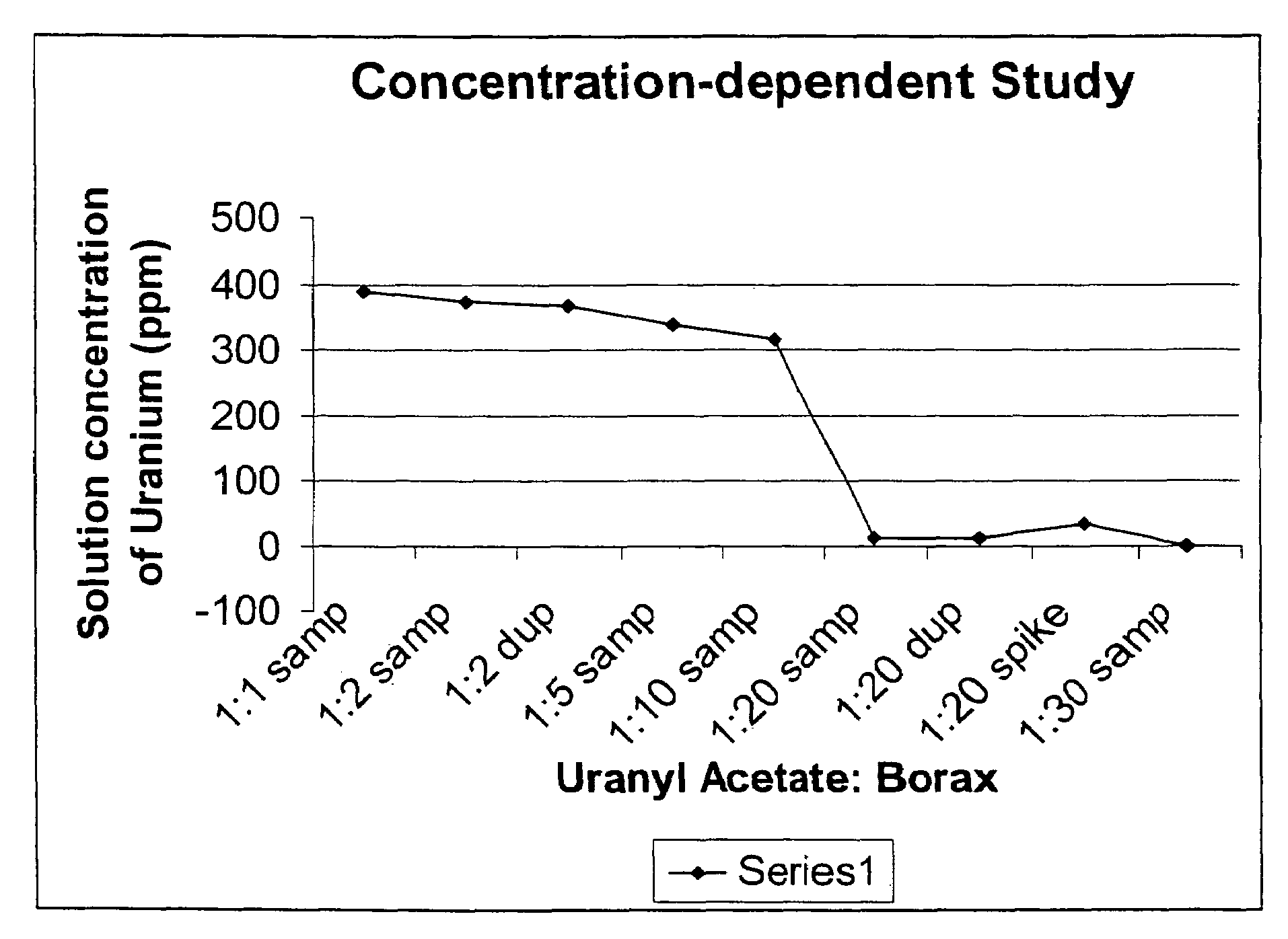Use of boron compounds to precipitate uranium from water
a technology of boron compounds and uranium, which is applied in the direction of contaminated groundwater/leachate treatment, radioactive contaminants, separation processes, etc., can solve the problems of preventing the dispersion of uranium, and no techniques that irreversibly bind the uranyl dication ion, so as to promote the precipitation of uranium, enhance the effect of borax in binding the uranyl dication and removing uranium
- Summary
- Abstract
- Description
- Claims
- Application Information
AI Technical Summary
Benefits of technology
Problems solved by technology
Method used
Image
Examples
example 1
Preparation of Uranyl Borax Precipitate at pH 4
[0029]100 mL of a 0.00957 M stock solution of uranyl diacetate was taken in an Erlenmeyer flask. The pH of the solution was 4. Meanwhile, 0.364 g of borax was dissolved in 100 mL of deionized water in a 100 mL volumetric flask. Subsequently, the borax solution was added to the uranyl solution. The resultant yellow solution gave a precipitate over one week. Precipitation increased over a period of 4 weeks.
[0030]Yield: 0.2442 g
[0031]m. p.: >400° C.
[0032]IR / Raman: 3448, 1636, 1536, 1472, 1384, 1098, 1055, 932, 677, 610, 486
[0033]TGA: 40-180° C. (6.6%, 1.9 mg), 220-380° C. (1.8%, 0.5 mg), 640-710° C. (0.27%, 0.08 mg), 910-970° C. (0.67%, 0.19 mg)
[0034]XRD: not UO2(BO2)2, UO2(CH3COO)2, and not Borax
[0035]BET: 0.6286±0.0586 m2 / g (non-porous coarse powder)
[0036]U content: (289.021 ppm / 1000 ppm), B content: (41.53 ppm / 1000 ppm)
example 2
Concentration-Dependent Study
[0037]A 0.00957M stock solution was prepared by dissolving 2.03 g of UO2(CH3COO)2 in 500 mL of water. 50 mL aliquots of the stock solution were added to six centrifuge bottles with a 50 mL volumetric pipette. Meanwhile, stock solutions of Borax were prepared in 1:1, 1:2, 1:5, 1:10, 1:20 and 1:30 molar ratios. Subsequently, 200 mL of each stock solution was added to the six centrifuge bottles via a volumetric pipette (see Table 1). The mixtures were centrifuged at 18,592 G (gravity) / 10,000 r.p.m. for 20 mins at 22° C.
[0038]
TABLE 1Composition of uranyl-borax solutionsWeight of theUranyl-BoraxUranylNo. of molesSolutions inAcetate:of BoraxBorax stock250 mL centrifugeBoraxrequiredsolutionsbottles (g)0.04244.785 * 10−40.182 g / 200 mL308.661:2 9.57 * 10−40.456 g / 250 mL308.211:5 2.39 * 10−31.139 g / 250 mL308.861:104.785 * 10−3 2.28 g / 250 mL308.821:20 9.57 * 10−318.24 g / 1 L 308.541:300.0143627.38 g / 1 L 308.61
[0039]The supernatants were decanted into 250 mL Er...
example 3
Uranyl Acetate:Borax:Sodium Dodecyl Sulfate (Surfactant) Ratio Dependent Study
[0041]A 0.00957M stock solution was prepared by dissolving 0.03 g of UO2(CH3COO)2 in 500 mL of water. Aliquots of 10 mL were added to centrifuge bottles with a 10 mL pipette. Also, stock solutions of borax were prepared in 1:1 and 1:20 ratios. These were added to the centrifuge bottles in 30 mL aliquots, and were measured with a graduated cylinder. The sodium dodecyl sulfate solutions were prepared in 25 mL volumetric flasks in concentrations of 1:1, 1:2 and 1:20. Relative proportions of reagents are presented in Table 3.
[0042]
TABLE 3Composition of uranyl:borax:surfactant mixturesUranium:No. of moles / L ofBorax:No. of moles / L ofNo. of moles / L ofSodium DodecylSurfactantUranyl AcetateBoraxSulfate0.042369.57 × 10−59.57 × 10−50 mol / 0.025 Lmol / 0.010 Lmol / 0.030 L1:1:19.57 × 10−59.57 × 10−59.536 × 10−5 / mol / 0.010 Lmol / 0.030 L0.025 L1:1:29.57 × 10−59.57 × 10−51.914 × 10−4 / mol / 0.010 Lmol / 0.030 L0.025 L1:20:19.57 × 10...
PUM
| Property | Measurement | Unit |
|---|---|---|
| pH | aaaaa | aaaaa |
| pH | aaaaa | aaaaa |
| pH | aaaaa | aaaaa |
Abstract
Description
Claims
Application Information
 Login to View More
Login to View More - R&D
- Intellectual Property
- Life Sciences
- Materials
- Tech Scout
- Unparalleled Data Quality
- Higher Quality Content
- 60% Fewer Hallucinations
Browse by: Latest US Patents, China's latest patents, Technical Efficacy Thesaurus, Application Domain, Technology Topic, Popular Technical Reports.
© 2025 PatSnap. All rights reserved.Legal|Privacy policy|Modern Slavery Act Transparency Statement|Sitemap|About US| Contact US: help@patsnap.com



